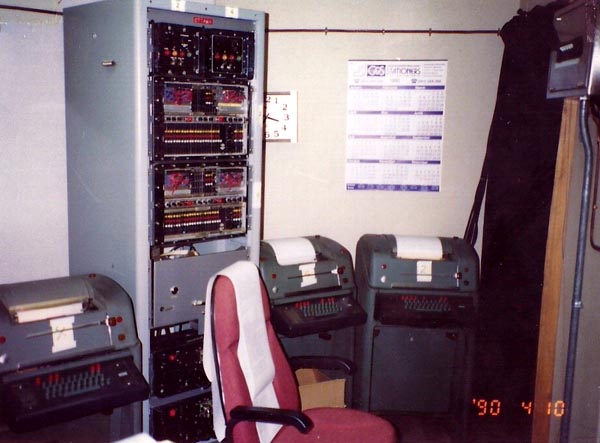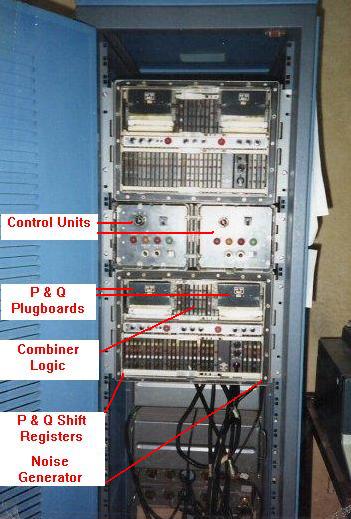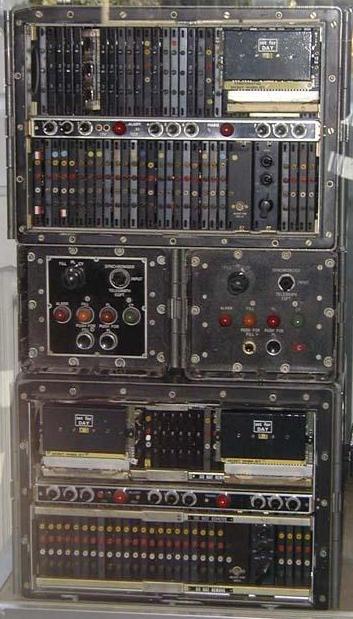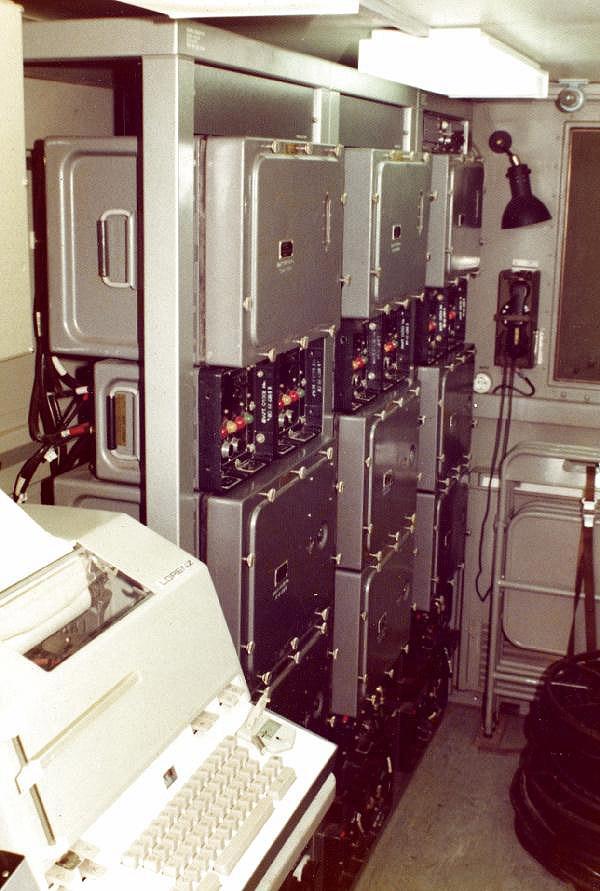 |
| Three BID 610 racks with shields removed. The shields would only be removed to reconfigure the plugboards. It would otherwise be a Tempest violation to operate Alvis without the shields in place. (Photo courtesy of the COMWEB Museum. |
The BID 610, a crypto machine of British design introduced in the 1960's, was the first fully transistorized full duplex on-line cipher machine used by the British Army. It operated in two modes: Mode A which was start/stop (Asynchronous) and Mode B which was fully synchronous operation over a land line or radio circuit. In Mode B, a BID 700 synchronizing unit had to be used. BID 610 could handle information up to TOP SECRET level. It was used from the 1960's to the 1980's.
This machine was also used by Canada's Foreign Service communicators. They were employed at Canada's larger diplomatic missions and were used to communicate to various government departments. Pictured above are three separate BID 610's in a rackmount configuration. Each of the "circuits" is identified with dymo tape at the top of the cabinet.
David Smith, a former Canadian Foreign Service Communicator recalls some details about the Alvis plugboards. "The first BID 610 units we used did not have removable plug boards but rather the cords and plugs were hard-wired directly to the back of the panel and were red and white in colour. There were two sets - one on the left and one on the right of the unit near the bottom. These were a real annoyance for two reasons:
1) The operator could not change the patch cords in advance of the end of the crypto period. That meant one operator had to be immediately available to start the reconfiguration for the next day's settings. If any problems were encountered in setting up the patch cords, that would result in down time and missed messages. To their credit, these patch cords were very flexible, durable and easy to remove and insert from their sockets.
2) Accessibility to the patch cords was awkward to say the least. One had to sit on a chair and bend over to ensure each cord was placed in it's proper configuration.
To avoid too much disruption to our communications, crypto "change-over" times or Hotel Julliette as it was known in the military, were staggered and of course, had to be done when the mission operator was actually present and also keeping in mind the world time zones we had to contend with.
In later years, the BID 610 was redesigned to accept programmable plug boards. This permitted the operators to change to the next day's settings in advance. All the operator had to do was simply remove the old plugboard and install the new one which contained the next day's settings. Unfortunately , these new plugboards came with their own Achilles heel which was the fragility of the wires themselves".
George McKeever, also a former Canadian Foreign Service Communicator, recalls. "A BID 610 was configured via plugboard. Normally, the plugboards were covered with flat grey covers for security purposes. The individual plug boards were set using a daily keymat setting. There were two boards required for each side of the duplex circuit. They were printed circuit boards (PCB's) about three by five inches in size, with a edge connector for positioning them into the BID equipment. The "P" board had an uninterrupted edge connector, and the "Q" board had a small slot cut into one side of the connector, so the type could be differentiated. There were thirty wires soldered in a row along the bottom of the PCB, each with a simple straight plug at the end which was inserted into a receptor. The receptors were within three rows above the wire row.
Setting up a plugboard was simple. Pulling out the plugs would zeroize the old key. Then, the wires were straightened out and ordered so that you could find them easily. Next, the wires were set according to the current keymat. The easiest way was to start with the lowest row of receptors and work up, so the lower row of wires was underneath. It would only take a couple of minutes to set one up, but we had a large number of BIDs, each requiring 4 plug boards. At the back of the COMCENTER , there was a table that was used for setting up the boards. At the start of each day it was filled with plugboards all awaiting the new keymat. While we were there, we would be called by "the BOX" (the system controllers in a climate controlled shell) and our secondary duty would be to change circuit sets.
Lots of things could go wrong with these plugboards. Wires often broke, usually as the operator was finishing off the top row. On occasion, the receptors would break off. Broken boards were sent to the tech shop so they could be resoldered. To test the sets, electronics technicians had build a simple test box, with four slots, two for "P" and two for "Q". A simple light display indicated that the sets were identical.
The various "circuits" were also differentiated
by colour and used a different keymat. For example, a large group
of Canadian missions were "Yellow" and used the same keymat. Those BID610's
had a big yellow label with the circuit name on it. The other colours
were Orange, Red and Black".
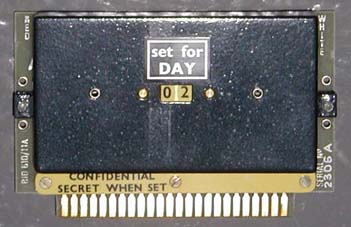 |
| Closeup of the plugboard with cover on. The indicator window show the day of the month for which the settings are valid. John Roy underscores one of the inconveniences of programming the card. "The closer you got to the end of the setting the more difficult it was to get insert the plugs into the sockets due to the increasing density of connections and the difficulty of dodging the wires which already had been installed". The Canadian version of the plugboard had knurled knobs to keep the cover in place. Once the daily key change was done, the date would be adjusted so it would show through the window and the big metal cover would be replaced and secured by tightening the knurled screws. (Photo courtesy John Alexander) |

